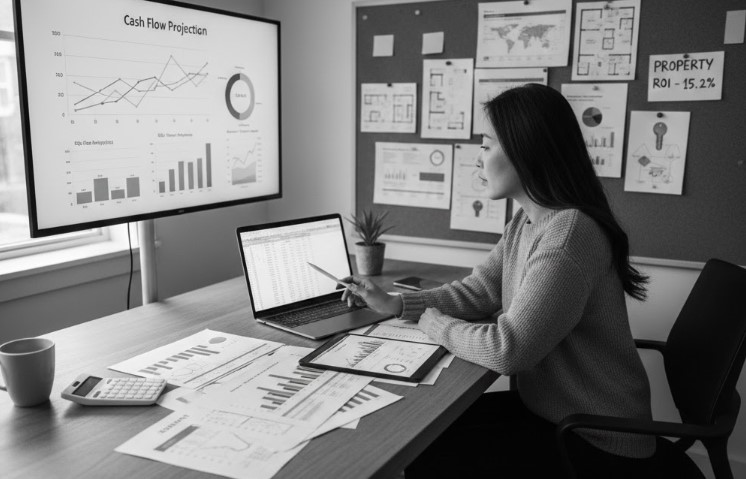Table of Contents
- What Does It Really Mean to Analyze a Real Estate Investment?
- The Four Pillars You Can’t Ignore
- The Essential Metrics (Explained Like You’re 10 Years Old)
- How Do You Know If a Real Estate Investment Is Good?
- Practical Tips to Invest with a Cool Head and a Calm Heart
- One Final Question for You
- Investing Is More Than Numbers
Have you ever felt like investing in real estate is like walking through a territory where everyone seems to know more than you? We’ve all been there. And that’s why understanding real estate investment analysis from a human, relatable perspective—without overcomplicating it but still keeping it rigorous—is so important. Today, we’re going to break down this topic so you can look at any property with different eyes—the investor’s eyes.
Before we go on, a friendly disclaimer: this article isn’t a magic recipe. It’s more like a map filled with signs, small anecdotes, and a few questions that will make you pause for a second. And trust me, thinking is the foundation of any good investment.
What Does It Really Mean to Analyze a Real Estate Investment?

Real estate investment analysis is like looking under the hood of a car before buying it. From the outside, it may look spectacular—shiny paint, spotless windows, the seller smiling… but what’s inside? How far is it truly going to take you?
In practical terms, this analysis is the process of evaluating whether a property is worth its price, whether it can generate sustainable income, whether it fits your goals, and whether the risk is within your tolerance. On paper it sounds obvious. But in real life, emotion and intuition can betray you.
Sometimes we fall in love with the perfect apartment overlooking the ocean… and forget to ask whether the condo has debt or if the area actually has rental demand. Has that ever happened to you—falling in love before running the numbers? It has happened to me.
The Four Pillars You Can’t Ignore

These pillars are like the legs of a table: if one fails, the whole thing wobbles. And trust me, no one wants to invest in a wobbly table.
The Product: The Property Itself
Here we talk about the tangible side:
- Where is it located?
- What is its real condition?
- What is the level of demand?
- Does it need repairs?
Think of it like buying a used phone. It looks nice, but the moment you turn it on you realize the battery lasts ten minutes. Real estate can be exactly the same.
It happened to me: A few years ago, I visited a property that looked impeccable from the outside. New roof, fresh paint, a well-kept garden. Everything seemed perfect. Until the owner casually said, “Oh, well… we have a few minor plumbing issues, but nothing serious.”
Spoiler: it was serious. And expensive.
That “minor issue” doubled my projected operating expenses. See why analysis is key?
The People: Tenants and Management
Many beginner investors overlook this part. Who lives—or will live—there? How stable is the building’s management? Are there delinquent tenants? How quickly do they respond to a water leak?
A bad property manager can turn a great property into a constant headache.
Also, analyze your own profile:
- Are you a patient person?
- Do you tolerate dealing with tenants?
- Are you willing to delegate management?
Real estate investment analysis also includes understanding yourself.
The Environment: Market and External Factors
Here we include the things you cannot control—but must understand:
- Local market trends
- Supply and demand in the area
- Nearby development projects
- Overall economic conditions
A property can be in perfect condition, with excellent tenants… but if the neighborhood is declining or people are moving out, profitability can suffer.
The real estate market is like the weather: you can’t control it, but you can prepare for a sudden downpour.
The Money: Financing, Debt, and Capital
This is a delicate point. Debt can amplify your profits… or crush them.
Here you analyze things like:
- Interest rates
- Financing costs
- Amortization
- Debt-coverage capacity
A smart investor doesn’t just look at how much a property costs, but how much financing it will truly cost them.
The Essential Metrics (Explained Like You’re 10 Years Old)

Cash Flow: Your Monthly Oxygen
Does the property leave you money after paying expenses and debt?
If the answer is no, something’s off.
A real estate investment without positive cash flow is like a bicycle without brakes: exciting, but dangerous.
Internal Rate of Return (IRR)
Don’t be intimidated by the name.
IRR is simply a way to measure how fast your investment grows over time.
You can think of it as your money’s “real speed.”
Net Present Value (NPV)
An elegant way to calculate how much the future profits are worth today.
It’s like pulling money from the future and bringing it into the present using math that doesn’t hurt when explained properly.
Cap Rate
Cap rate is one of those metrics people mention as if everyone was born knowing it.
But in reality, it’s very simple:
Cap Rate = Net Operating Income (NOI) ÷ Property Value
It helps you compare properties.
If two properties generate the same income but one costs less… the cheaper one has a better cap rate. Simple.
How Do You Know If a Real Estate Investment Is Good?
There’s no absolute truth, but there are signs you can use:
- Compare scenarios: optimistic, realistic, and pessimistic.
- Evaluate your risks: can you handle a 3-month vacancy?
- Have a clear exit plan: sell, refinance, or hold?
- Ask yourself: What happens if things don’t go exactly as planned?
Some properties look amazing on paper… until you test them through a realistic lens.
Practical Tips to Invest with a Cool Head and a Calm Heart

Learn to Use Your Tools
Excel can become your best friend (even if sometimes it feels like your worst enemy).
Mastering it helps you avoid calculation mistakes—which in real estate, can be very expensive.
Do Your Own Due Diligence
Check everything.
And when you think you’ve checked enough… check a little more.
Rent rolls, contracts, maintenance history, taxes—everything matters.
Ask for Help When You Need It
You’re not “less of an investor” for asking questions.
In fact, the best investors do it constantly.
Diversify
Don’t put all your resources into a single property.
If one fails, make sure it doesn’t sink your entire ship.
One Final Question for You
If tomorrow someone offered you a property that looks perfect…
what is the first thing you would analyze?
Your honest answer to that question reveals a lot about your investor personality.
Investing Is More Than Numbers

Real estate investment analysis goes beyond formulas.
It’s about understanding the market, the people, the money… and yourself.
Investing isn’t just a skill; it’s an internal dialogue between your goals, your fears, and your vision for the future.
And if there’s one thing I hope you take from this article, it’s this: when you know how to analyze properly, investing stops being a leap into the void… and becomes a firm step toward your goals.

